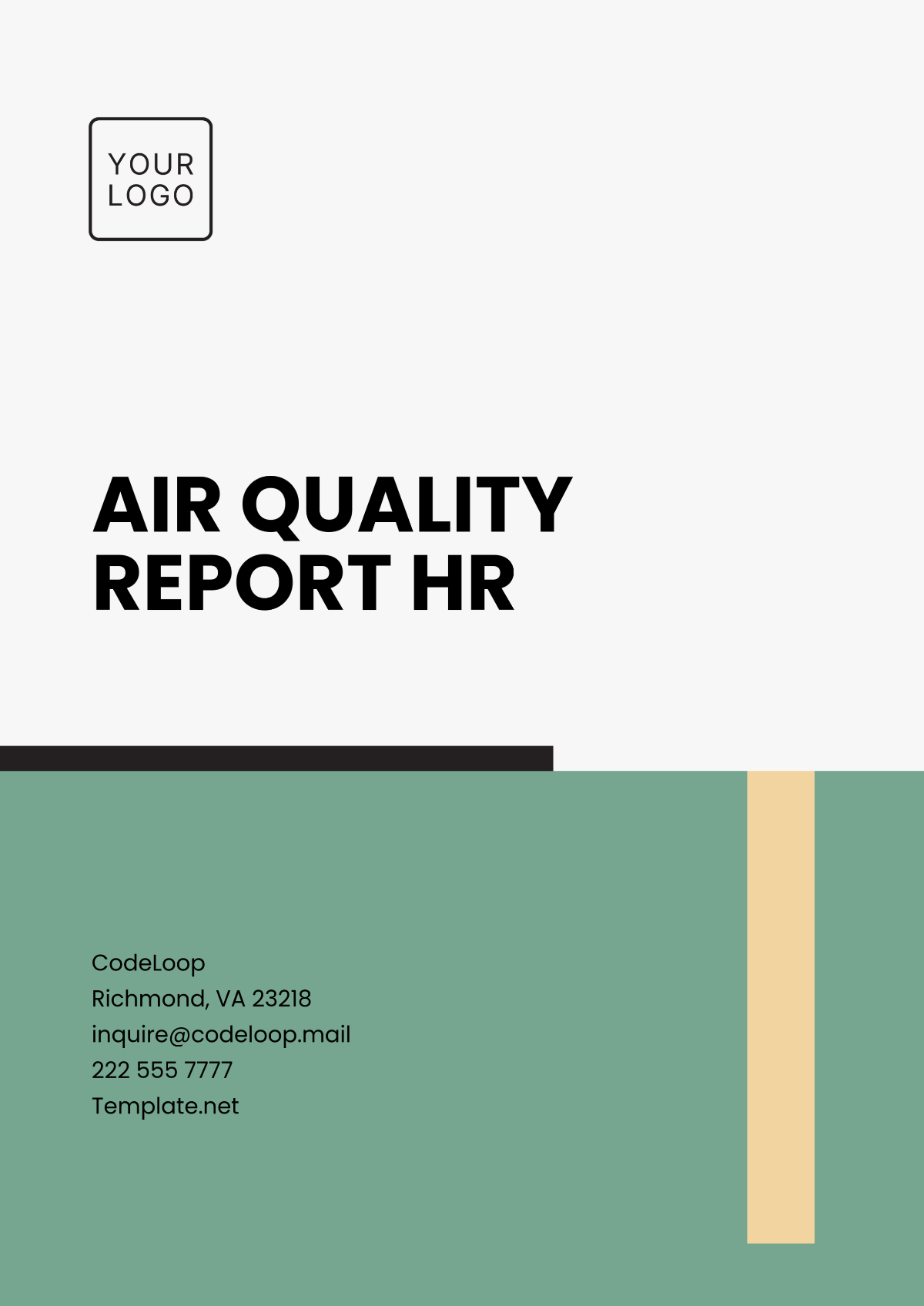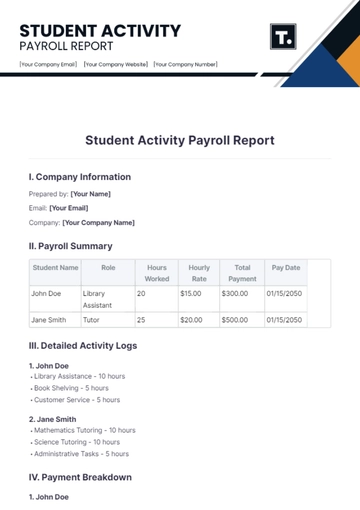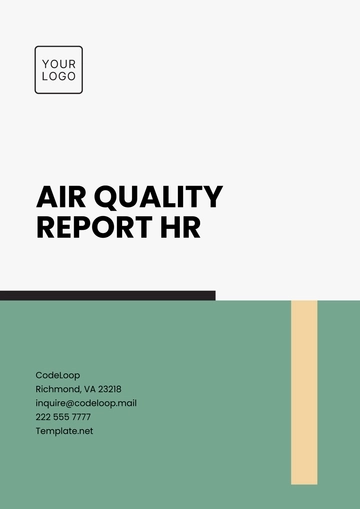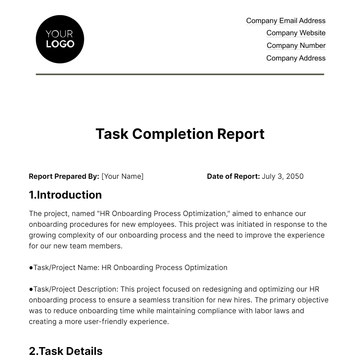Free Air Quality Report HR

Prepared by: [Your Name]
Company: [Your Company Name]
Date: [Insert Date]
This report aims to provide a detailed analysis of the air quality within the Human Resources (HR) department's facilities. We will evaluate current air quality levels, identify potential sources of pollutants, propose mitigation strategies, and offer recommendations for maintaining a healthy working environment.
Introduction
The importance of maintaining good air quality in the workplace cannot be overstated. Poor air quality can lead to a range of health issues, which can, in turn, impact employee productivity and well-being. This report provides an in-depth analysis of the air quality in the HR department's office space.
Current Air Quality Measures
The air quality was measured using both manual and electronic devices over one month. Various parameters, including particulate matter (PM), volatile organic compounds (VOC), carbon dioxide (CO2) levels, and overall humidity, were considered.
Particulate Matter (PM) Levels
Particulate matter is a mixture of solid particles and liquid droplets in the air. It is categorized by size, usually PM2.5 and PM10. These were the observed levels:
Measure | Average Level (µg/m³) | Recommended Standard (µg/m³) |
|---|---|---|
PM2.5 | 15 | 12 |
PM10 | 30 | 20 |
Volatile Organic Compounds (VOC) Levels
VOCs are chemicals found in many materials used in the office. Prolonged exposure to VOCs can have significant health impacts.
Source | VOC Level (ppb) | Recommended Maximum (ppb) |
|---|---|---|
Office Furniture | 300 | 250 |
Cleaning Products | 150 | 100 |
Carbon Dioxide (CO2) Levels
High levels of CO2 can lead to drowsiness and decreased productivity. The following table details the CO2 levels detected during the measurement period:
Time Slot | CO2 Level (ppm) | Acceptable Limit (ppm) |
|---|---|---|
Morning | 420 | 400 |
Afternoon | 550 | 400 |
Humidity Levels
Proper humidity is crucial for comfort and health. Low humidity can lead to dry skin and respiratory issues, while high humidity promotes mold growth. Recorded humidity levels were as follows:
Minimum Humidity: 30%
Maximum Humidity: 60%
Recommended Range: 30%-50%
Sources of Air Pollution
Several sources contribute to indoor air pollution in the HR department. The primary sources identified include:
Office Equipment: Printers and copiers emit ozone and other particles.
Cleaning Agents: The use of chemical-based cleaning products contributes significantly to VOCs.
Building Materials: Paints and varnishes lead to prolonged VOC emissions.
Ventilation Issues: Inadequate ventilation increases the concentration of indoor pollutants.
Mitigation Strategies
Several strategies have been identified to improve air quality within the HR department:
Improved Ventilation
Enhancing the ventilation system can significantly decrease pollutant concentration. Installing more energy-efficient HVAC systems with HEPA filters is advisable.
Adoption of Green Cleaning Products
Switching to eco-friendly, low-VOC cleaning agents reduces indoor VOC levels while maintaining cleanliness standards.
Regular Maintenance
Conducting regular maintenance of office equipment to minimize emissions and optimize air quality.
Indoor Plants
Placing air-purifying indoor plants can naturally reduce CO2 levels and improve the overall indoor air quality.
Recommendations
To maintain a healthy environment in the HR department, the following recommendations should be considered:
Monitor air quality regularly to identify and address any issues proactively.
Educate staff on the importance of maintaining clean air and encourage reporting of any air quality issues.
Review and, if necessary, revise cleaning and maintenance schedules to ensure they align with air quality goals.
Consider installing air purifiers in high occupancy areas to quickly address pollution spikes.
Conclusion
The air quality within the HR department's facilities currently falls outside recommended standards in several areas. By implementing the proposed mitigation strategies and following the recommendations outlined, the department can significantly enhance air quality, benefiting employee health and overall productivity.
- 100% Customizable, free editor
- Access 1 Million+ Templates, photo’s & graphics
- Download or share as a template
- Click and replace photos, graphics, text, backgrounds
- Resize, crop, AI write & more
- Access advanced editor
Elevate your HR practices with the Air Quality Report HR Template from Template.net. This editable and customizable document seamlessly integrates into your workflow, providing a comprehensive snapshot of air quality data. Utilize the intuitive AI Editor Tool to tailor reports, ensuring a healthier and more informed workplace for your team. Breathe easy, work confidently.
You may also like
- Sales Report
- Daily Report
- Project Report
- Business Report
- Weekly Report
- Incident Report
- Annual Report
- Report Layout
- Report Design
- Progress Report
- Marketing Report
- Company Report
- Monthly Report
- Audit Report
- Status Report
- School Report
- Reports Hr
- Management Report
- Project Status Report
- Handover Report
- Health And Safety Report
- Restaurant Report
- Construction Report
- Research Report
- Evaluation Report
- Investigation Report
- Employee Report
- Advertising Report
- Weekly Status Report
- Project Management Report
- Finance Report
- Service Report
- Technical Report
- Meeting Report
- Quarterly Report
- Inspection Report
- Medical Report
- Test Report
- Summary Report
- Inventory Report
- Valuation Report
- Operations Report
- Payroll Report
- Training Report
- Job Report
- Case Report
- Performance Report
- Board Report
- Internal Audit Report
- Student Report
- Monthly Management Report
- Small Business Report
- Accident Report
- Call Center Report
- Activity Report
- IT and Software Report
- Internship Report
- Visit Report
- Product Report
- Book Report
- Property Report
- Recruitment Report
- University Report
- Event Report
- SEO Report
- Conference Report
- Narrative Report
- Nursing Home Report
- Preschool Report
- Call Report
- Customer Report
- Employee Incident Report
- Accomplishment Report
- Social Media Report
- Work From Home Report
- Security Report
- Damage Report
- Quality Report
- Internal Report
- Nurse Report
- Real Estate Report
- Hotel Report
- Equipment Report
- Credit Report
- Field Report
- Non Profit Report
- Maintenance Report
- News Report
- Survey Report
- Executive Report
- Law Firm Report
- Advertising Agency Report
- Interior Design Report
- Travel Agency Report
- Stock Report
- Salon Report
- Bug Report
- Workplace Report
- Action Report
- Investor Report
- Cleaning Services Report
- Consulting Report
- Freelancer Report
- Site Visit Report
- Trip Report
- Classroom Observation Report
- Vehicle Report
- Final Report
- Software Report


















